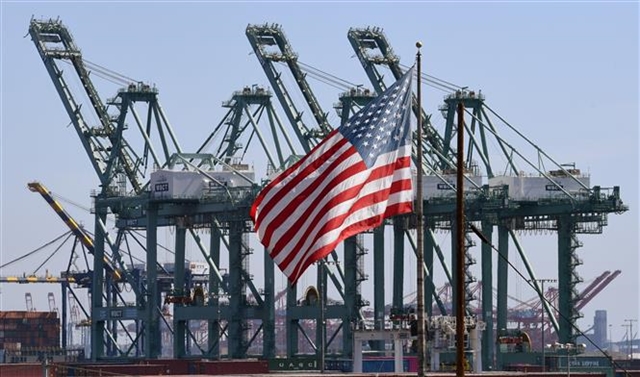May has arrived not with a retreat from investors, but with cautious optimism, driven by a mix of macroeconomic resilience, policy adjustments and shifting investor sentiment.

HÀ NỘI — As the saying goes, "Sell in May and go away" - a well-worn adage in global financial markets. In Việt Nam, too, it has become an annual ritual for investors to revisit this phrase every early May. The implication is clear: exit the market during this period and wait for a better time to return.
The origin of this seasonal caution lies in the market’s typical lack of new information during this time, which often leads to stagnating investor sentiment and lower trading activity. Many participants tend to hold back on disbursements, while some opt to sell off their holdings, keep cash on hand and sit out in search of fresh opportunities in the following months.
Yet in Việt Nam, this seasonal investment strategy may no longer hold water. May 2025 has arrived not with a retreat from investors, but with cautious optimism, driven by a mix of macroeconomic resilience, policy adjustments and shifting investor sentiment.
April was a turbulent month for Việt Nam’s stock market. The VN-Index fell by nearly 6 per cent, largely due to the US Department of Commerce’s announcement of a 46 per cent countervailing duty on certain Vietnamese products. The news rattled investors, triggering widespread uncertainty amid ongoing geopolitical friction, particularly between the US and China.
However, sentiment quickly rebounded when Washington later suspended the duty for 90 days and signalled a willingness to resume negotiations. That move helped stabilise market expectations and prevent a broader sell-off.
At the same time, the country's economic fundamentals delivered a dose of optimism. First-quarter GDP growth hit 6.93 per cent, the highest quarterly increase in the past five years.
This momentum was complemented by the Government's continued commitment to public investment and by Việt Nam’s retention on FTSE Russell’s watchlist for potential reclassification to secondary emerging market status.
The successful rollout of the long-awaited KRX trading system also served as a technical milestone that reinforced market confidence.
As a result, the VN-Index has managed to recover to the 1,200 – 1,230 range, establishing a temporary equilibrium zone. Liquidity also improved markedly. Average daily trading value across the three stock exchanges in April rose 17.1 per cent month-on-month, reaching approximately VNĐ26.6 trillion (US$1 billion).
Nevertheless, the market is not without its vulnerabilities.
Foreign investors have continued their selling streak, with net outflows totalling VNĐ39.1 trillion since the beginning of the year. Of that, VNĐ13.2 trillion was withdrawn in April alone, the largest monthly foreign sell-off since June 2024.
The strong net selling reflects concerns over external risks and valuation pressures, despite the market’s recovery.
Historically, however, the “Sell in May” trend has not consistently applied to the Vietnamese market.
Over the past decade, the VN-Index has posted gains in May seven times, declining only three times.
The most notable exception came in May 2020, at the height of the COVID-19 pandemic, when the index surged 12.4 per cent due to a retail investor boom and a liquidity-driven rally. More recently, in May 2024, the VN-Index climbed 4.3 per cent month-on-month.
Given these precedents, many market observers suggest that this May could defy conventional wisdom once again.
Several key factors are at play, including a strong start to the corporate earnings season, continued momentum in public investment projects and expectations of further foreign capital inflows should Việt Nam achieve an upgrade to emerging market status.
These elements, combined with supportive macroeconomic indicators, suggest a foundation for stability — if not growth.

While global risks remain on the horizon, particularly in terms of monetary policy shifts and trade disputes, the domestic landscape offers enough reassurance for investors to consider going against the seasonal grain. Rather than fleeing the market, some may see May as an opportunity to accumulate positions and prepare for a longer-term uptrend.
VNDirect Securities forecasts that the index may fluctuate between 1,200 and 1,280 points as investors await clear signals from the US – Việt Nam trade negotiations starting May 7.
The ability to surpass the strong resistance zone at 1,270 – 1,280 will depend heavily on negotiation outcomes, particularly whether the US reduces its proposed countervailing duties to below 20 per cent, or whether the State Bank of Việt Nam cuts policy rates to support growth, VNDirect noted.
SSI Securities sees the market in a consolidation phase and believes the VN-Index could retest the 1,280 – 1,300 range. However, its analysts caution that this is likely a technical rebound within a broader neutral-to-bearish trend, given continued uncertainty around US tax policy.
SHS Securities, on the other hand, offers a more optimistic outlook. The firm argues that the market has already priced in substantial downside risk, creating room for medium-term investors to re-enter. SHS expects the VN-Index to trade within the 1,150 – 1,270 band in the near future.
Meanwhile, Việt Dragon Securities (VDSC) expresses concern that the VN-Index may face technical corrections as it approaches the 1,300 resistance level, particularly amid fragile investor sentiment and a lack of institutional buying momentum.
The market benchmark closed last week at 1,301.39 points, down 0.9 per cent. — BIZHUB/VNS





